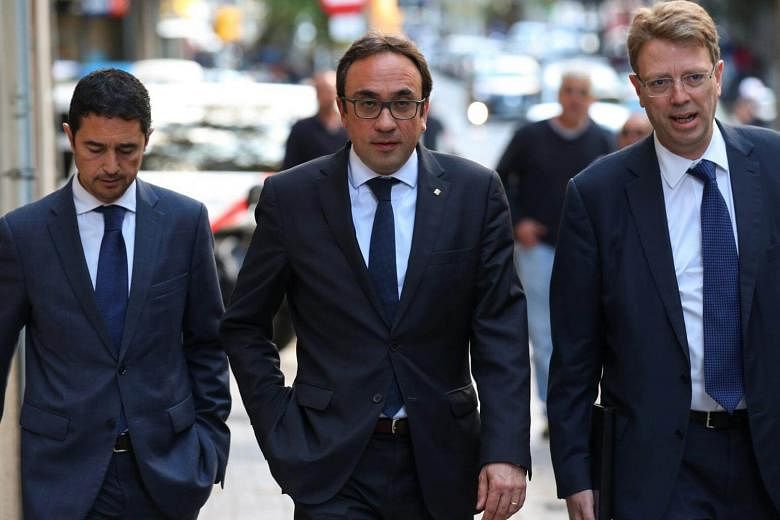BARCELONA, SPAIN (WASHINGTON POST) - Defiant separatist leaders in Catalonia showed up for work on Monday (Oct 30) despite having been relieved of their duties by Spain's national government over the weekend.
At least one minister of the now-ousted regional government was allowed to enter his offices in an apparent climbdown by Madrid, which took over Catalonia after its regional Parliament declared independence from Spain on Friday.
Other senior officials also went to work.
Spanish Prime Minister Mariano Rajoy had earlier said he would bar the way to the separatist Catalonian leaders continuing to rule their region.
Spain's Interior Minister said the leaders would briefly be allowed into their former offices to gather their belongings.
"Continuing with planned agenda," wrote Mr Josep Rull i Andreu on Twitter, who until last Friday was Catalonian Minister of Land and Sustainability.
He published a photograph of himself at his computer in his office, but left about an hour later.
The top leader of Catalonia's secession effort, Mr Carles Puigdemont, also posted an enigmatic photo on Instagram that appeared to be the interior courtyard of Palau de la Generalitat, the seat of Catalonia's government.
"Good day," he wrote as its caption, apparently hinting that he was at work inside the building.
The soft touch from Madrid suggested that national leaders were trying to avoid a physical confrontation as Catalonia's secession crisis deepens.
But Madrid has still left open the possibility of charging Catalonian leaders with sedition.
Just a day earlier, hundreds of thousands of Spaniards filled the streets to show they are against an independent state in Catalonia and for the central government's takeover of the breakaway republic.
And, many added, they wanted to see the leaders of the attempted secession punished.
It was not so much a protest as a victory march. They believed they had won. There would be no "Republic of Catalonia".
As the streets swelled with an estimated 300,000 or more demonstrators, many waving Spanish flags, there were chants urging authorities to arrest Mr Puigdemont - who as Catalan regional president led the move toward independence - and his top lieutenants.
"To jail!" they shouted.
Ms Inés Arrimadas of the Citizens party in Catalonia told reporters before the march began that "the silent majority of Catalans are once again taking to the street to show that the majority of Catalans feel Catalan, Spanish and European".
Ms Arrimadas walked out of the Catalan regional Parliament on Friday as it cast the vote for independence, which was quickly thwarted.
Frustrated by the defiant but divided Catalan Parliament, the central government last Saturday began to assert control over Catalonia, firing the region's president, ministers, diplomats and police chiefs and transferring all authority to Madrid.
Since then, the secessionist leaders have been mostly absent from the public stage - not exactly in hiding, but close.
Mr Puigdemont on Saturday issued a brief, pre-recorded call for citizens to mount "a democratic opposition" to the takeover. No one was exactly sure what he meant.
Two top leaders of the Catalan secessionist movement are already in jail, without bail, as prosecutors mull sedition charges.
The Spanish newspaper El Periódico reported that Spain's Interior Ministry on Sunday ordered the Catalan regional police stations to take down portraits of Mr Puigdemont.
After being awarded sweeping powers by the Spanish Senate last week, the central government in the early morning hours of Saturday published lists of more than 140 Catalan officials, alongside their advisers, who were being fired.
The Catalan Parliament was also dissolved by order of Spain, and new elections were scheduled for Dec 21.

